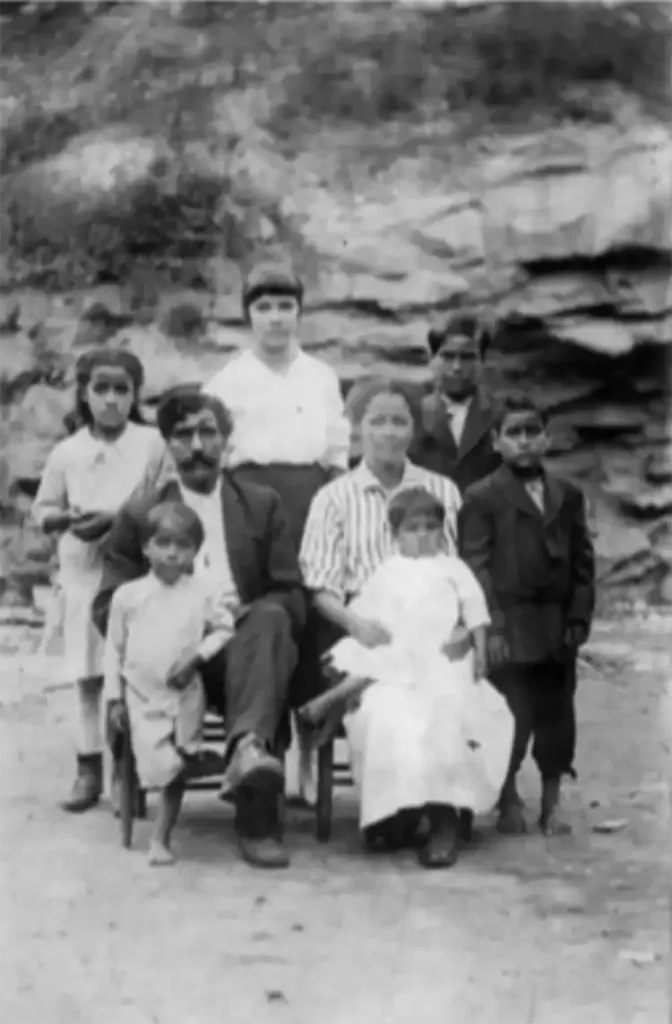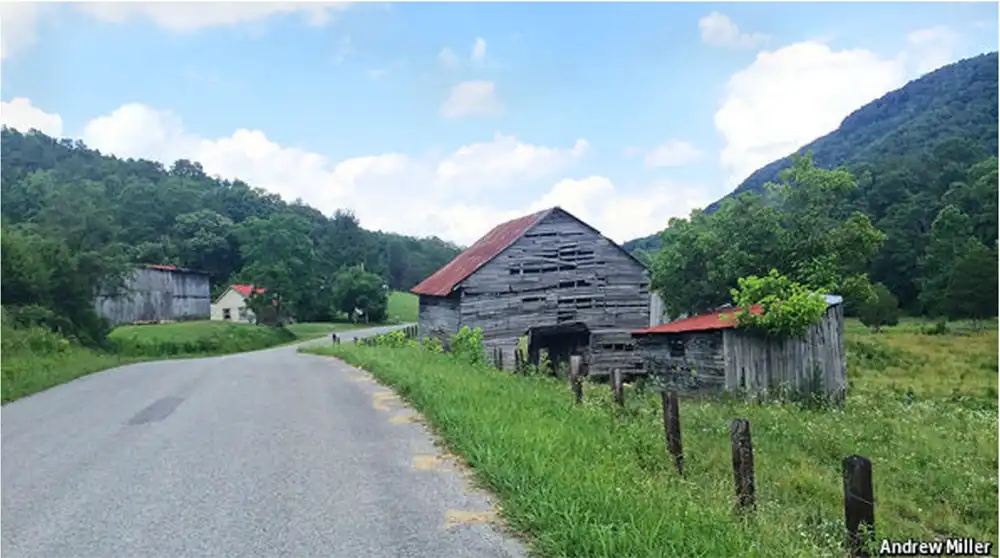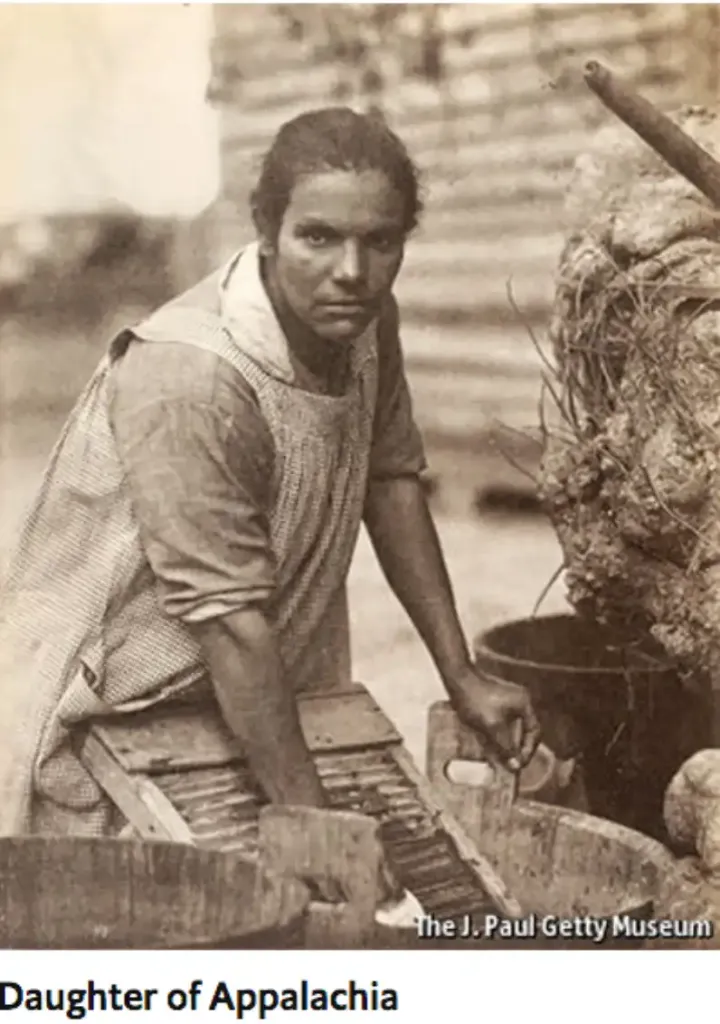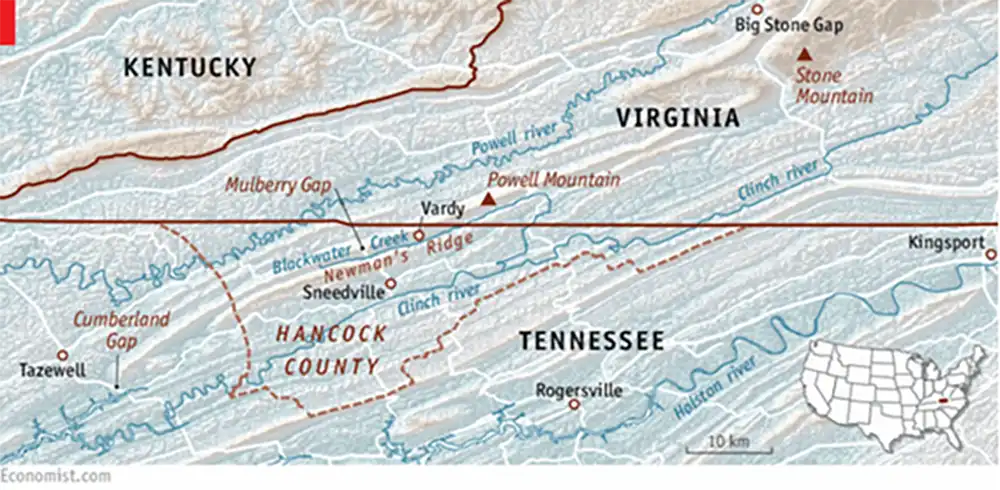The Melungeons in North America

The Melungeons[1] have been described by “many writers” as “a clannish race of people that inhabit the Cumberlands[2] and whose origin lies shrouded in the haze of an uncertain past.”
“They were mountaineers, but there was a difference between them and their white neighbours.” “They were dark-skinned, but little about them resembled Italians or Mexicans.” “Native whites called them ‘Melungeons’. In some ways they reminded people of certain Indian tribes, yet they had other characteristics that suggested a mixture of many races. For example, some of them had the dark skin and curly hair typical of blacks, but even so seldom possessed black facial features.” “Their skin was dark and oily, showing more of a coppery colour than of, say, Ethiopians or darker members of the white race. Their hair was often coarse and black, and in some families extremely kinked.
Others were little different from their white neighbours, with brown or black wavy hair, gray or blue eyes, and rather high cheekbones. I even recall another type among the Melungeons: those with dark, slightly curly hair, smooth dark skin, and dreamy eyes that seemed almost Oriental.” “The fact that individual members of these groups have such a wide variation of physical characteristics has given rise to numerous theories concerning their origin.”[3]
[1] Melungeon (pronounced /məˈlʌndʒən/ or “muh’lun-jun” or “muh-lun’jun”) is a term traditionally applied to one of a number of “tri-racial isolate” groups of the Southeastern United States, mainly in the Cumberland Gap area of central Appalachia, which includes portions of East Tennessee, Southwest Virginia, and East Kentucky. Tri-racial describes populations thought to be of mixed European, sub-Saharan African, and Native American ancestry.
Although there is no consensus on how many such groups exist, estimates range as high as 200. DNA testing of Melungeon descendants has been limited, but the Melungeon DNA Project, which has made its results public, so far shows overwhelming mixed European and sub-Saharan African haplotypes of females and males in several families traditionally identified as Melungeon and considered so by researchers. Descriptions of Melungeons have varied widely over time; in the 19th and early 20th century, they were sometimes called “Portuguese” to “Native American” to “light-skinned African American.” Other Melungeon individuals and families are accepted as white.
[2] Originally in the vicinity of Cumberland Gap (East Tennessee and Eastern Kentucky). Later migrations to throughout the United States).
[3] Bonnie Ball “The Melungeons.” [Notes on the origin of a race]. Revised, The Overmountain Press, Johnson City, Tennessee, 1992, p.v

Figure 2 – From The Economist Aug 27th 2016 edition
The word Melungeon, traditionally considered and used as an insult by many, is of disputed origin. Some connect it to the French mélange, meaning mixture, others to the Portuguese-African word perhaps from Angola or Mozambique, from mulungo, also malungu or malungo, meaning (ship)mate, companion/friend, white person or sir.[1]
Some other hypotheses have been ventilated, like an origin in Latin malignus, and its different European derivations, or in the Greek word melas, meaning dark,[2] but one way or the other, this can be of minor or no relevance as to the origin of the group.
“Some writers appear to be trying to connect the term “Melungeon” and the ethnic origin of people designated by that term, but there is no basis for this assumption. It appears the name arose as something which others, of whatever origin, called the multiracial people.”[3]
[1] You may find a summary of some of these points in the “Frequently asked questions” section of the Melungeon Heritage Association website, as well as plenty of documents in the “Resources for Research” respective section.
[2] As ventilated by Bonnie Ball ibidem, p.ix.
[3] From “Melungeons” in Wikipedia, as accessed August 18, 2020.

In order to dissipate so many doubts a series of DNA studies have been conducted as of today. “Taken as a whole, such findings appear to verify the 19th-century designation of Melungeon ancestors as “mulattos”, that is, descendants of white Europeans and Africans. The line with a variety of haplogroup with roots in Portugal, Spain and Italy is consistent with historian Ira Berlin’s research showing that some of the charter generation of enslaved or servant people in the Chesapeake Bay colony were Atlantic creoles.
They had Spanish or Portuguese paternal ancestors and African mothers. They were descended from African women and European men; the latter worked in the slave trade at ports in Africa run by Spain and Portugal, and took wives from the indigenous population.”[1]
Several theories have been ventilated and explored, by Bonnie Ball[2] and others:
- “A band of ship-wrecked Portuguese sailors wandered from the North Carolina coast into the hills of east Tennessee, married Cherokee Indian maidens, and lived undisturbed until the white man drove them westward.”[3] “…[O]lder Melungeons always claimed positively that they were Portuguese”.[4]
- …[T]hey were descendants of Sir Walter Raleigh’s ‘Lost Colony’, which disappeared from Roanoke Island, North Carolina, about two decades before the English finally established a permanent settlement in America, at Jamestown[5], Virginia. “[6] They would have, “beset by wilderness hardships, moved west, settled with the Indians, and became the forebears of the Melungeons.”[7]
- “More likely than any of these theories, however, is the possibility that Cherokee Indians married with Europeans who came to this country in more conventional ways – that is, as settlers and explorers. Settling in the mountains, they became isolated from the rest of the world (as Hancock County has remained, to a large extent, to this day); and when they were discovered by the French, they became ‘Melungeons’, the word coming from the French Mélange, meaning mixture.”[8]
- “Another conjecture is that they were a mixture resulting from a tumultuous period of frontier warfare involving the white captive, the slave, and the Indian captor.”[9]
- “Another theory, widely accepted in the Cumberlands, centers around stories recorded by local historians saying that Hernando de Soto, in his explorations of the Southeast, penetrated a corner of east Tennessee and southwest Virginia during the sixteenth century. Some believe that the Melungeons may have descended from members of his party, lost or captured by the Indians.” [10]
- “According to Mr. Crawford, there is another authentic clue as to the origin of the Melungeons. When John Sevier organized the State of Franklin (later Tennessee), a colony of ‘dark-skinned, reddish-brown complexioned people’ already existed. They were supposed to be ‘of Moorish descent, were neither Indian nor black but claimed to be Portuguese. This leads to the most fascinating theory of all – that the Melungeons may have been pure-blooded Carthagenians’. [11] Further research, Mr. Crawford says, yelded traditions that Melungeons descended from the ancient Phoenicians, who migrated from Carthage to Morroco, crossed the Strait of Gibraltar, and settled in nortern Portugal. A colony of these Moors is believed to have crossed the Atlantic before the American Revolution, settling in North-Carolina.”[12]
- …”[S]ome people believe the Melungeons descended from the Welsh, who allegedly constructed an old fort near Manchester, Tennessee. This happened (supposedly) before Christopher Columbus discovered America. The article[13] adds that there are several references in early Americana to ‘Welsh Indians’, who could have been Melungeon forerunners.”
Among the basic context of curiosity on who the Melungeons are, and where they come from, Bonnie Ball[14] raises and tries to answer following specific questions, while stating right ahead[15], that her “favorite possibility” is “the Croatoan (or Croatan) Indians and the Lost Colony…”:
- Do they have English ancestry? Are they descended from the Lost Colony?
- Do they have Indian ancestors? If so, what tribes?
- Is there a connection with the ‘Lumbee’ Indians?
- Is there a relationship to the Blue Ridge and Piedmont tribes?
- Is there a Portuguese ancestry?
- Did de Soto’s party have any connections with the Melungeons?
- What role did slaves play in the evolution of the Melungeons?
- From whom did they inherit their endurance to hardy, outdoor living? Their superstitions? Their dialects?
- Why is their history so vague? Why is it so difficult to enumerate them, and give statistics?
- Are there other kindred people, and if so, where are they?
Bonnie Ball draws her conclusions in the shape of answers to her above questions:[16]
- “It is reasonable almost beyond doubt that the Melungeons had English ancestry. They were still speaking a form of Elizabethan English as recently as fifty years ago, and that form of our language is in use even now wherever Melungeon families cling together. Their English surnames supply further confirmation, although conclusive proof will probably always elude us.”
- “Perhaps the strongest evidence of their Indian ancestry is found in the written accounts of the English colonies at Roanoke Island. It is quite probable that these settlements had a few people who escaped the Indian massacres,” … and went “to live with friendly Indians who protected them (something, again, impossible to prove). These were the Croatoans, or so one would assume. According to historians, the Croatoans had some previous white admixture, which would likely have been Spanish or Portuguese.”
- It is possible there is a connection with the ‘Lumbee’ Indians of Robeson County, North Carolina, who spoke Elizabethen English. “The Lumbees were apparently a fusion of white blood and that of another Indian tribe to the southeast, which may have been the Cheraw or Creek tribe. However, their English blood is a sense suggests an indirect relationship with the tribe later called ‘Melungeon’.”
- “I tis also possible that there is a relationship between the Melungeons and the Blue Ridge and Piedmont tribes, but the evidence is slight. Only once did we read of the claim of these tribes to Portuguese ancestry. They could have been extensions of the Maryland and Delaware groups, who, in some instances, also claim Portuguese ancestry.”
- “As I see it, Portuguese ancestry is likely; all the older Melungeons have claimed it. It could only have occurred through contacts of shipwrecked Portuguese sailors and the Indians of the Carolinas who were friendly with the white colonists. …[T]he Portuguese theory has been too long-standing and consistent to ignore.”
- “It is unlikely that De Soto’s party had any connection to the Melungeons, even though there has been a persistent tradition that de Soto did travel as far northward as Scott County, Virginia. But since De Soto was Spanish and died in 1542 (a quarter of a century before the first the first English colony arrived), it does not appear to have been an acceptable theory – that is, unless the Spanish descendants later mated with Indian-white mixtures from eastern North Carolina.”
- “Due to the caste system operating on them, many Melungeon groups have, at one time or another, been thrown into close contact with blacks, especially during the periods when Melungeons were forced to attend black schools and churches, and live close together. Another possibility is that during colonial warfare the Indians often killed white male settlers, taking their wives and daughters, as well as slaves, captive. In this way the three races could have mixed. However, in the case of the Melungeons, it does not likely go back that far.”
- “The unusual endurance of the Melungeons to a hardy, outdoor existence may have come, at least in part, from their Indian ancestors. There are also indications that some of these qualities may have come from Portuguese and Moorish ancestors. Through lack of written history and the evident fusion of the races, only the Elizabethan English and white mode of dress have survived, with (possibly) some old English superstitions and ideas. Naturally, Melungeons have acquired many of the Indian customs that fit into their lives in the wilderness. Their dialects are still (mostly) old English.”
- “Their history is vague because of their lack of written records in the first place. Those with Indian ancestry have lost contact with their early forbears for the same reason. And those with Negro ancestry have done likewise. …[T]here is no accuracy in names of races given in census and court records. Since Melungeons attended white schools, or Indian schools (or, now, integrated schools), there is no way of identifying who went where, or when, and thus no way of obtaining meaningful statistics. The opening of coal mines and other industries in southwestern Virginia, eastern Tennessee, and Kentucky has served to bring many of the Melungeons outo f their mountain retreats seeking employment. Some have married whites and in many cases have lost their identity.”
- “And finally, we have shown that the Melungeons have many kindred peoples scattered all over the landscape. They reside in Virginia, North and South Carolina, Georgia, and many other places. But like the Melungeons they too are dying out, going back the way they came, by intermarriage and assimilation, disappearing forever into the maelstrom that is called the greta American melting pot.”
My insights:
They called themselves Portuguese, “Portyghee”, or Porty-gee.[17]
They carry/adopted almost exclusively English sounding (family) names.
No written documents, neither objects.
They predominantly adopted protestant religion, even if unsually venerating the Christian cross.
Inconclusive DNA results, except that most of them point to a three races combination.[18]
Several other theories have been ventilated, but deserve perhaps even less attention than some mentioned above.[19]
Drama “Walk Towards the Sunset” written by Kermit Hunter, tells the story of the Melungeon people, a disenfranchised group centered in Hancock County. The play ran as an outdoor drama for 1969-1975 in Sneedville, and was run again for a brief weekend in 2011 at tiny Walters State Community College, located a mere 30 miles down the road from Sneedville.
“Deliverance”, a 1972 American thriller film produced and directed by John Boorman, and starring Jon Voight, Burt Reynolds, Ned Beatty and Ronny Cox, and especially its featured ‘duelling banjos’ scene, invoked in me reminiscences of the Melungeon culture and whereabouts.
“The story of the Melungeons is at once a footnote to the history of race in America and a timely parable of it.”[20]
“After the passage of Virginia’s “one drop” law in 1924, whereby anyone with a trace of blackness was classified accordingly, Walter Plecker, the monstrous registrar of the Bureau of Vital Statistics, singled the Melungeons out for persecution. To American eugenicists like him, such liminal groups were degeneration incarnate.”[21]
[1] From Wikipedia as accessed August 18, 2020
[2] “The Melungeons. Notes on the Origin of a Race”, The Overmountain Press, Johnson City, Tennessee, 1992
[3] Bill Rawlins “East Tennessee Melungeons Have a Past Clouded in Myth Knoxville News-Sentinel, October 10, 1958, as quoted from Ball, p.vi
[4] Bruce Crawford “Letters to the Editor”, Coalfield Progress, Norton, Virginia, July 11, 1940, as quoted from Boniie Ball, ibidem, p.vi
[5] Jamestown followed no fewer than eighteen earlier failed attempts at European colonization of North America, including the famous “Lost Colony” at Roanoke Island in what is now Dare County, North Carolina, and the ill-fated Spanish Ajacan Mission, established thirty-six years earlier by Jesuit priests less than fifteen miles from Jamestown, Virginia. The only successful settlement that preceded Jamestown was the Spanish settlement St. Augustine, Florida, established in 1565.
[6] Bonnie Ball ibidem, p.vi-vii
[7] Bill Rawlins ibidem, p.vii
[8] Bill Rawlins ibidem, p.vii.
[9] Bonnie Ball ibidem, p.viii.
[10] Bonnie Ball ibidem, p.viii.
[11] “An export trade of Cypro-Phoenician mass-produced bronze art replicas was carried out by Carthaginian ships visiting America”, against an input of gold and lumber. (Fell, Barry “Saga America”, Quadrangle, New York, 1980, p.86 – second hand quote from Moore & Lewis 1999, p.218)
[12] Bonnie Ball ibidem, p.viii-ix
[13] “Melungeons – The Mistery People of Tennessee”, Tennessee Conservationist, August, 1959, as quoted from Bonnie Ball, ibidem, p.ix
[14] Ibidem, p.ix-x.
[15] Ibidem, p.1
[16] ibidem, p.94-99
[17] “They deeply resented the name ‘Melungeon’ given them by whites, and proudly called themselves Portuguese.” Bonnie Ball ibidem p.67
[18] https://en.wikipedia.org/wiki/Melungeon_DNA_Project
[19] Like the one “sub-theory”, which “sees them as exiled conversos, Iberian Jews who hid their faith to escape the Inquisition before fleeing to the New World.”, in “An American mystery. Down in the valley, up on the ridge. An Appalachian people offers a timely parable of the nuanced history of race in America”, The Economist, Aug 27th 2016
[20] The Economist, ibidem
[21] The Economist, ibidem


